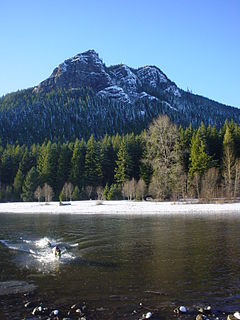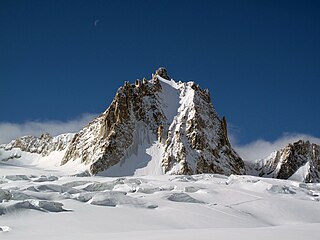Related Research Articles

Mountaineering is the set of activities that involves ascending mountains. Mountaineering-related activities include traditional outdoor climbing, skiing, and traversing via ferratas. Indoor climbing, sport climbing and bouldering are also considered mountaineering by some.

Cliffhanger is a 1993 American action-adventure film directed by Renny Harlin and starring Sylvester Stallone, John Lithgow, Michael Rooker and Janine Turner. Based on a concept by climber John Long, the film follows Gabe, a mountain climber who becomes embroiled in a heist of a U.S. Treasury plane flying through the Rocky Mountains. Released on 28 May 1993, the film earned $255 million worldwide.
The Cross of Valour was established in 1975 as the highest Australian Bravery Award. The awards were established as part of the institution of the Australian Honours System. The Cross of Valour has been awarded to five Australian civilians and, although there has been no Australian military recipient, they would be eligible in situations where normal honours to the military do not apply.

Vertical Limit is a 2000 American survival thriller film directed by Martin Campbell, written by Robert King, and starring Chris O'Donnell, Bill Paxton, Robin Tunney, Temuera Morrison, and Scott Glenn. The film was released on December 8, 2000, in the United States by Columbia Pictures, receiving mixed reviews and grossed $215 million at the box office.

Rattlesnake Ridge is the ridge of Rattlesnake Mountain located south of North Bend, Washington, United States. The western end is near the intersection of State Route 18 and I-90 in Snoqualmie, Washington, and runs southeast about 7 miles (11 km) or 11 miles (18 km) by trail. It is the highest and easternmost of the Issaquah Alps. A maze of abandoned logging roads and constructed trails have been strung together to provide a 10.5-mile (16.9 km) footpath from the Snoqualmie Point trailhead at Exit 27 on I-90 all the way to the Rattlesnake Lake trailhead near Exit 32.

Swiss Air-Rescue is a private, non-profit air rescue service that provides emergency medical assistance in Switzerland and Liechtenstein. Rega was established on 27 April 1952 by Dr Rudolf Bucher, who believed the Swiss rescue organization needed a specialized air sub-section. Rega mainly assists with mountain rescues, though it will also operate in other terrains when needed, most notably during life-threatening emergencies. Rega also provides a repatriation and medical advice service for members who experience a medical emergency while abroad and local treatment is not available.

Northeast Airlines Flight 946 was a domestic U.S. flight from Boston, Massachusetts, to Montpelier, Vermont, with a scheduled stop in Lebanon, New Hampshire, operated by Northeast Airlines. On October 25, 1968, some time during the evening, the Fairchild Hiller FH-227 aircraft crashed on Moose Mountain while descending on approach. The crash killed 32 of 42 passengers and crew. Of the fatalities, four were employees from the National Life Insurance Company who were returning from a business trip. The fatalities also included a reporter for the Barre Daily Times and six social workers of the Vermont Head Start Supplementary Training Program on a conference trip. Ten passengers survived the crash with minor or moderate injuries. After the crash, Northeast Airlines continued flight service until its merger with Delta Air Lines in the early 1970s.
Velvet is a black lab-shepherd cattle mixed-breed dog, owned by Matty Bryant of Milwaukie, Oregon, who helped save three climbers, including Bryant, when they became stranded on Mount Hood, Oregon, on February 18, 2007.

Mount Hood climbing accidents are mountain climbing- or hiking-related incidents on Oregon's Mount Hood. As of 2007, about 10,000 people attempt to climb Mount Hood each year. As of May 2002, more than 130 people have died climbing Mount Hood since records have been kept. One of the worst climbing accidents occurred in 1986, when seven teenagers and two school teachers froze to death while attempting to retreat from a storm.

The greatest potential for injury while rock climbing occurs when a lead climber falls. Several published studies have researched climbing injuries, especially lead climbing injuries and how to avoid them. Chances of neck and head injuries are very low and they can be avoided by falling correctly.

A Bell 206L-4 LongRanger helicopter, tail number TC-HEK, operated by Medair while on a charter flight en route from Çağlayancerit in Kahramanmaraş Province to Yerköy in Yozgat Province, crashed on March 25, 2009 at around 16:00 EET when it struck Mount Keş in central Turkey. The pilot and four passengers, including the leader of the Great Union Party (BBP) Muhsin Yazıcıoğlu, were killed in the accident. Only one passenger survived the crash with injuries and made an emergency call. Due to harsh weather conditions at the crash site, the victims and the wreckage could be recovered only after two days, and the injured passenger was found dead five days later under snow.

Mount Maroon is a mountain in South East Queensland that is part of the McPherson Range. The mountain rises to 966 m (3,169 ft) above sea level about 12 km west of Rathdowney.

Dale E. Stovall is a retired Brigadier General in the United States Air Force who figured prominently in several search and rescue operations during the Vietnam War. A member of the 40th Aerospace Rescue and Recovery Squadron based in Thailand, on June 2, 1972, he recovered Capt. Roger Locher from deep inside North Vietnam, the deepest rescue made during the entire Vietnam War. For his efforts in rescuing Locher, Stovall was awarded the Air Force Cross, which described how "he willingly returned to this high threat area, braving intense ground fire, to recover the downed airman from deep in North Vietnam.". Stovall was also recognized with the 1973 Jabara Award for Airmanship, two Silver Star awards and two Distinguished Flying Cross awards for other combat rescues among the 12 successful rescue missions he accomplished during his tour in Southeast Asia. Stovall retired from the Air Force as a Brigadier General on June 1, 1993.

During the afternoon of 25 April 2015, a MW 7.8 earthquake struck Nepal and surrounding countries. Shaking from the quake triggered an avalanche from Pumori into Base Camp on Mount Everest. At least twenty-two people were killed, surpassing an avalanche that occurred in 2014 as the deadliest disaster on the mountain.

The Tour Ronde is a mountain in the Mont Blanc massif of the Alps, situated on the border between France and Italy. It is a prominent mountain, some 3.5 km north-east of Mont Blanc, but is effectively part of a continuation of the south eastern spur of Mont Maudit which forms a frontier ridge between the two countries. It is easily accessible to mountaineers and provides not only a very good viewpoint from its summit of the Brenva face and the major peaks on the southern side of Mont Blanc, but it also offers a popular introduction to alpine climbing of all grades, including a north face ascent.

On 14 September 1982 a medical evacuation helicopter flight operated by Bristow Helicopters crashed during the early hours of the morning in driving rain and poor visibility over the North Sea. All six crew members on board died when their aircraft plunged into the sea near the Murchison platform while trying to locate the Baffin Seal seismic survey vessel.
The 1991 New Zealand bravery awards were announced via a Special Honours List dated 19 December 1991. Twelve of the 33 recipients were recognised for acts of bravery during the Aramoana Massacre on 13 November 1990.
The 1987 New Zealand bravery awards were announced via a Special Honours List on 27 August 1987, and recognised ten people for acts of bravery between 1984 and 1986.
The 1981 New Zealand bravery awards were announced via a Special Honours List on 17 December 1981, and recognised seven people for acts of bravery in 1980 or 1981.
The 1977 New Zealand bravery awards were announced via a Special Honours List dated 22 December 1977, and recognised six people for acts of bravery in 1976 and 1977.
References
- ↑ "Honours and awards" (PDF). New Zealand Gazette (57). 3 July 1975. p. 1482.